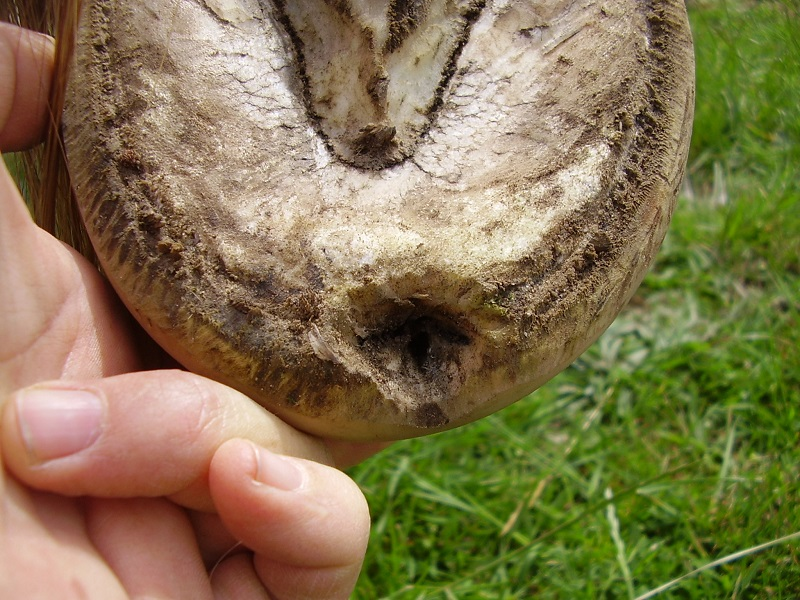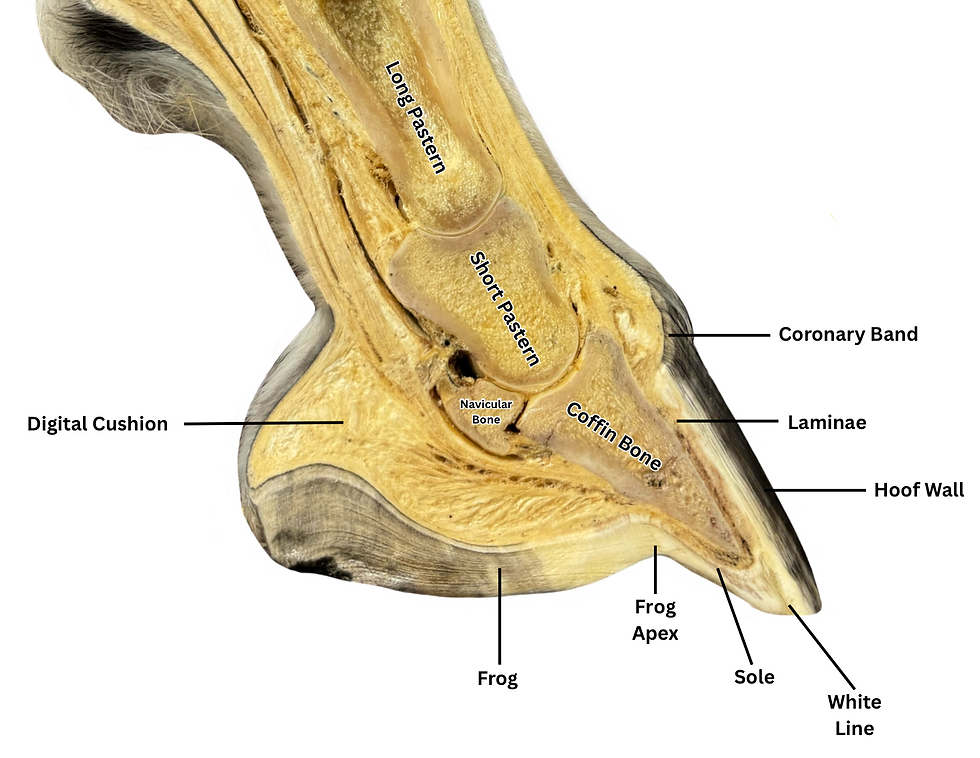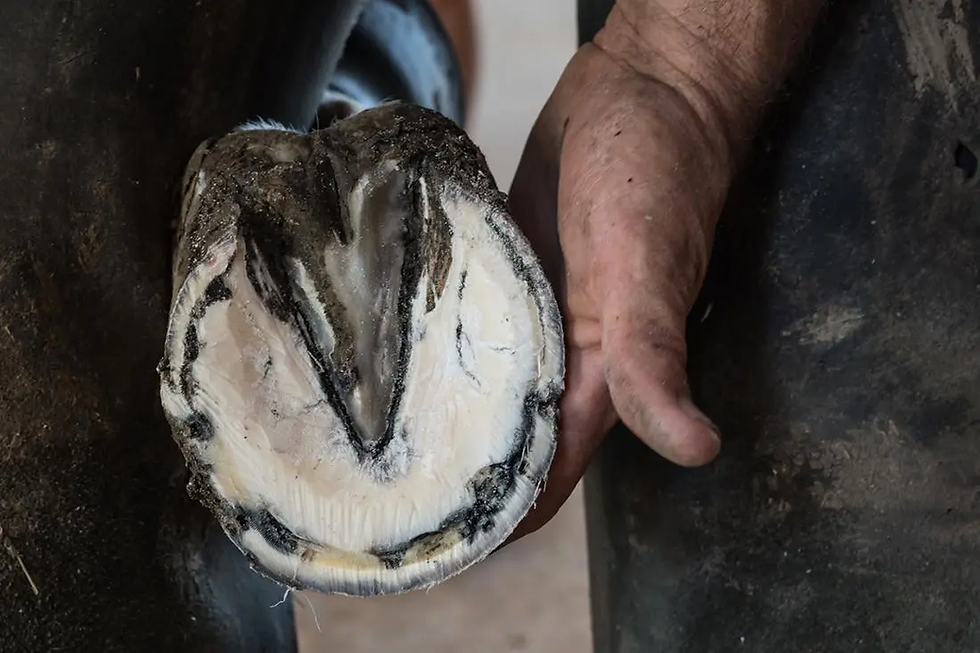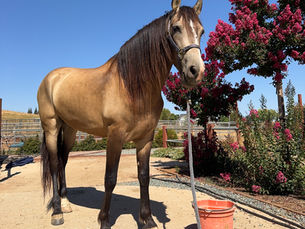Seedy Toe in Horses: Early Signs, Proven Treatments, and Prevention Tips
- Horse Education Online

- Aug 7, 2025
- 7 min read
Updated: Sep 2, 2025

Seedy toe is a common but often overlooked hoof condition that quietly compromises the structural integrity of the horse’s foot. In many regions of the U.S.—especially areas with wet spring and fall seasons—it is frequently mistaken for thrush and white line disease, yet it affects the hoof differently and requires a different approach.
This post breaks down exactly what seedy toe is, how to identify it early, and what treatments actually work. Whether you are a horse owner, equine student, or farrier, you will find step-by-step guidance, real case examples, and expert tips to prevent long-term damage and support full hoof recovery.
What Is Seedy Toe
Seedy toe refers to the breakdown of the connection between the outer hoof wall and the underlying structures of the foot, specifically in the toe area. This breakdown occurs at the white line, which is the junction where the hoof wall and sole meet. As the inner hoof wall separates, a cavity forms that can trap dirt, manure, and moisture, setting the stage for bacterial or fungal invasion.
Understanding the Anatomy

Seedy toe begins at the white line: the area where the hoof wall meets the sole. As shown in the image above, the laminae lie just inside the hoof wall and connect it to the coffin bone. When separation occurs here, debris and bacteria can get trapped, leading to a hollow cavity.
Unlike surface cracks, seedy toe affects the deeper connection between the hoof wall and internal structures. If left untreated, it can weaken the wall, lead to deep toe cracks, travel .
How It Differs from Thrush and White Line Disease
Unlike thrush, which affects the frog and thrives in deep crevices with poor hygiene, seedy toe starts at the toe of the hoof and typically feels dry and crumbly. There is no foul odor in early stages, and it often goes unnoticed without a close inspection.
It also differs from advanced white line disease, which can spread aggressively and involves bacterial and fungal infection within the hoof wall layers. Seedy toe is often an early-stage problem that can escalate into white line disease if not addressed quickly and effectively. You can read more about thrush to see how the two compare and overlap.
Main Causes and Risk Factors
Seedy toe is rarely caused by one issue alone. In most cases, it is the result of multiple stressors working together over time—many of which are especially common in regions with high rainfall or poor footing conditions.
Wet Environments and Poor Drainage

Moisture is the most common contributing factor. Prolonged exposure to wet bedding, muddy turnout, or poorly drained stalls weakens the white line and makes the hoof more susceptible to separation and infection. It's important to understand that moisture alone is not the issue: a moist environment facilitates the spread of urine and manure. Urine, with its ammonia contents, weakens the white line. Then, manure, which contains bacteria from the horse's digestive system, leads to seedy toe, white line disease, and thrush.
Long Trim Cycles and Flaring
Allowing too much time between trims leads to excess toe length and hoof wall flaring. This increases leverage on the white line, encouraging mechanical separation. A delayed breakover adds even more strain, especially on hard or uneven ground.
Nutritional Deficiencies
Hoof strength is directly tied to diet. Low levels of zinc, methionine, or biotin can weaken the hoof capsule, making it more prone to seedy toe. Horses with metabolic challenges or imbalanced forage may show chronic hoof issues unless supported with proper supplementation. For more, see The Basics of Equine Nutrition.
Structural Imbalances
Horses with preexisting hoof conformations are more vulnerable. High-low syndrome creates uneven loading across the feet, while a club foot places constant stress on the toe area—right where seedy toe usually forms. These horses often require specialized trimming and shoeing to avoid recurring wall separation.
Early Warning Signs Owners Miss
Seedy toe often starts silently. Catching it early means knowing what to look and feel for before there are visible cracks or lameness.
Hollow Sound at the Toe
Use a hoof pick or small hammer to tap around the toe. A healthy hoof should sound dense and solid. If you hear a hollow or drumlike tone, it may indicate a cavity forming between the hoof wall and the underlying laminae.
Crumbly or Chalky Horn

During cleaning, check the white line at the toe. If the horn appears soft, flaky, or breaks apart with gentle pressure, that’s a red flag. Early seedy toe often looks like dry rot or disintegrated horn material packed in the toe region.
Increased Digital Pulse
Palpating the digital arteries just above the fetlock can reveal subtle inflammation. A stronger or bounding pulse can be an early sign that something is brewing inside the hoof, even before heat or lameness appears. To learn how to check this properly, see The Horse’s Vital Signs.
These signs are easy to miss during daily care but can prevent a minor issue from becoming a major rehabilitation case. Next, we’ll cover how to confirm the diagnosis and when X-rays are necessary.
If abscesses keep returning at the same toe or quarter, think beyond seedy toe and screen for a keratoma. Details here: Keratoma in Horses.
Rehabilitation and Monitoring
Once the hoof wall has been debrided and treatment is underway, your focus shifts to strengthening new growth and avoiding relapse. Many horses with seedy toe recover well—but only if the aftercare stays consistent.
Nutritional Support
A hoof-strengthening diet can make or break your success. Ensure the horse is getting enough biotin, zinc, methionine, and lysine, particularly if they’re on hay-only forage. A low NSC diet is recommended, especially for horses with metabolic issues, as insulin resistance can slow healthy hoof growth and increase inflammation.
Exercise Adjustments
Avoid deep footing or uneven ground during recovery. Light turnout and controlled exercise on firm surfaces help promote circulation without putting strain on the regrowing wall. Horses in heart-bar or egg-bar shoes should be monitored for soreness and balance weekly.
Monitor with a Photo Log
Taking a photo of the sole and wall every two weeks helps track changes, compare progress, and detect early signs of relapse. Marking the wall with a Sharpie just above the damaged zone can also help visualize new growth over time. This is a practice many farriers use when managing chronic white line separation.
Prevention Checklist
Once a horse has had seedy toe, they’re more likely to develop it again—unless long-term changes are made. Here’s what to watch and adjust.
Maintain an Ideal Trim Cycle
Most horses need to be trimmed every five to six weeks in the summer and every six to eight weeks in the winter. Letting the toe flare between visits puts unnecessary stress on the white line. Horses prone to seedy toe often benefit from shorter trim cycles year-round, especially in regions with wet seasons or poor drainage, like the Pacific Northwest or Southeast.
Improve Stable Hygiene

Upgrade stall drainage with matting and gravel base layers to keep hooves dry. Regularly clean out manure and wet bedding to reduce exposure to bacteria and moisture. Even brief, repeated exposure to wet footing can soften the hoof enough to restart separation.
Check Hoof Walls Daily
Run your fingers along the toe during daily care. If you feel soft spots, cracking, or crumbly areas near the white line, intervene early. Spotting signs before they spread vertically up the wall is the key to avoiding major debridement.
Prevention is simpler and far cheaper than treatment. In the next section, we’ll show how a Quarter Horse recovered in six weeks—complete with photos, measurements, and lameness scores.
Conclusion and Next Steps
Seedy toe is one of those conditions that rewards early detection and steady management. It rarely resolves on its own and can easily be mistaken for other hoof issues like thrush or superficial cracking. But when caught early and treated with proper debridement, packing, shoeing, and nutrition, the prognosis is excellent.
To help you stay on top of care:
Explore our membership options to access exclusive hoof health resources, case studies, and step-by-step care guides: View Memberships
Browse our hoof-care flashcards and educational tools in the Horse Education shop
Review common lameness grading steps using our Comprehensive Guide to Equine Lameness
Even a small cavity at the toe can spiral into a serious problem if ignored. But with the right tools and a little training, you can stop seedy toe in its tracks—and build a healthier hoof from the inside out.
Frequently Asked Questions About Seedy Toe in Horses
Can seedy toe heal without removing the shoe?
Most farriers recommend removing the shoe to fully clean and medicate the cavity. This allows for better debridement and ensures nothing is trapping moisture or bacteria inside.
How long does it take for the hoof wall to regrow after debridement?
On average, it takes three to four months for a horse’s hoof wall to grow from the coronary band to the ground. Growth rates vary depending on age, season, diet, and health. Daily photos and visible tracking marks can help monitor progress.
Is seedy toe contagious between horses?
No, seedy toe itself is not contagious. It’s not a transmissible disease but a result of hoof wall separation and environmental or mechanical stress.
What disinfectants work best for daily packing?
Common options include iodine, copper sulfate powder, and antimicrobial clay products. Always apply disinfectants after thorough cleaning and drying of the hoof. Rotate between solutions if the condition stalls or worsens, and consult your farrier or vet if unsure.
When should I switch from heart-bar or egg-bar shoes back to regular shoes?
Shoeing can usually return to normal once the cavity is closed and the new wall is strong enough to bear weight without flaring or separating. This is typically after one or two full trim cycles, depending on severity. Work closely with your farrier to reassess after each reset.










Comments